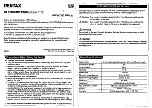
Instruction Manual
Baader CCS Herschel-Prism
-
11
-
Copyright Baader Planetarium GmbH, all rights reserved
-
Prime focus imaging (= direct connection of CCD or DSLR-camera body without camera lens)
Prime focus imaging is being applied when the complete Sun is to be imaged.
As shown in the image to the right the camera body is being connected onto
the Baader Safety Herschel-Prism using a standard 2"/T-2 nosepiece and T-
mount ring.
Rule of thumb for calclating the size of the Solar image on the chip plane:
APS camera chips: 1000mm focal length of the telescope will provide
approx. 10mm diameter of Solar image on the chip.
Initially leave the OD 3.0 neutral density filter as well as Solar Continuum filter
mounted inside the Prism body. Attach the camera and choose b/w mode.
Exposure times (at moderate ASA/ISO settings of 125) should be around
1/1000 sec. This ensures that seeing (air movement) will be almost
“
frozen
”
. If
1/1000 sec exposure times are not achieved, exchange the OD 3.0 filter
against a filter with OD 1.8 (#2458331) in order to shorten exposure time.
-
Afocal photography (= using a fixed-lens digital camera)
Afocal photography mostly is applied, if no DSLR camera is available and
the camera used is equipped with a non-removable zoom-lens. Afocal pho-
tography is a special version of projection photography. It can be applied for
imaging the complete Solar disc as well as for enlarged views of Solar re-
gions. The changing of so-called equivalent focal length is being effected by
varying the zoom factor of the digital camera lens.
Information concerning necessary accessories for afocal photography can
be found on our website under
Accessories/Adapters/Camera Adapters /Projection
Adapters
.
In our pdf
“
Digiscoping
”
you will find information about Afocal Photography.
You will find this pdf on our website under
Baader-Planetarium.com/Digiscoping
.
-
Projection photography
This method for Solar photography is used for detailed imaging of Solar
granules or individual Sun spots. In this case the focal image of the Sun
is being projected onto the imaging chip similar to projection techniques
used in a slide projector or beamer, see also on
AstroSolar.com
(only in
German language, please excuse).
In this case a projection system is being required which causes expo-
sure times to increase exponentially. For this kind of Solar photography,
webcams and video cameras are preferable which allow a stream of
images to be stacked. Also see on
AstroSolar.com
(only in German lan-
guage, please excuse).
Suitable projection lenses are:
Eyepieces with low distortion (preferable Ortho eyepieces)
Eyepiece holding systems such as Baader
OPFA
systems (on our
website under Accessories/Adapter/Camera Ad./Proj.Ad./
OPFA
).
Alternatively Baader
FFC
–
Fluorid Flatfield Converter, see also on
our website under
Accessories/Opt.Acc./Barlow Lenses/FFC
.
Whereas the Baader FFC will provide the highest known contrast and
sharpness of any projection eyepiece or barlow lens, owing to its two
fluorite doublet lens groups.
For initial test images using DSLR cameras, a simple barlow lens or ex-
isting photographic teleconverter may be used, which roughly doubles
the telescope focal length.


























